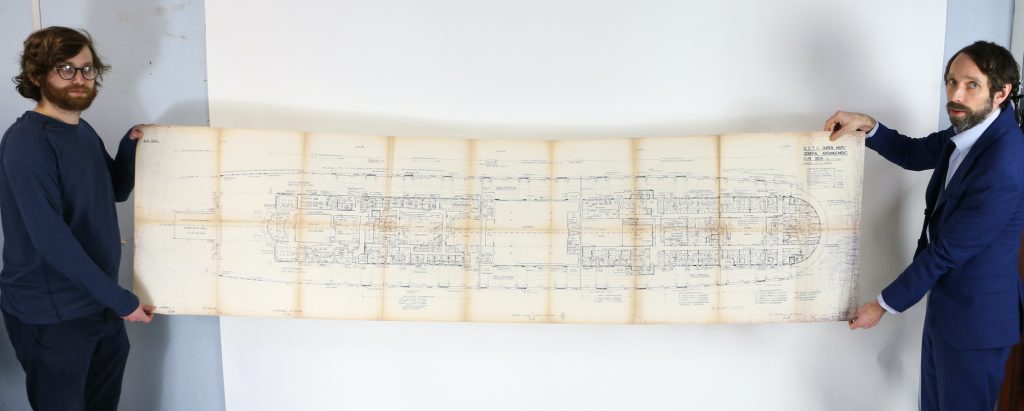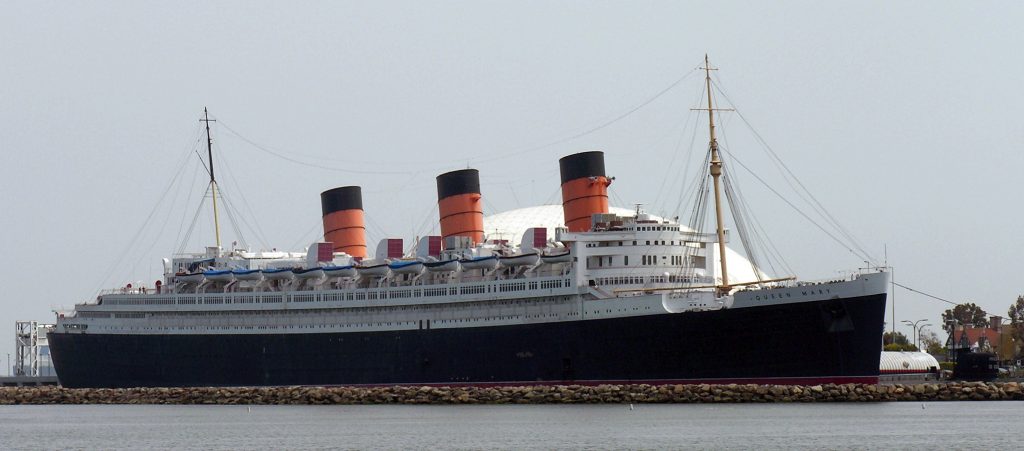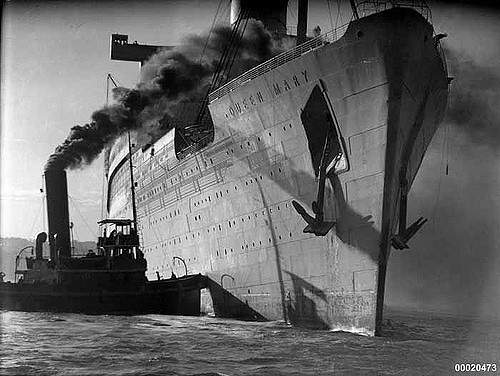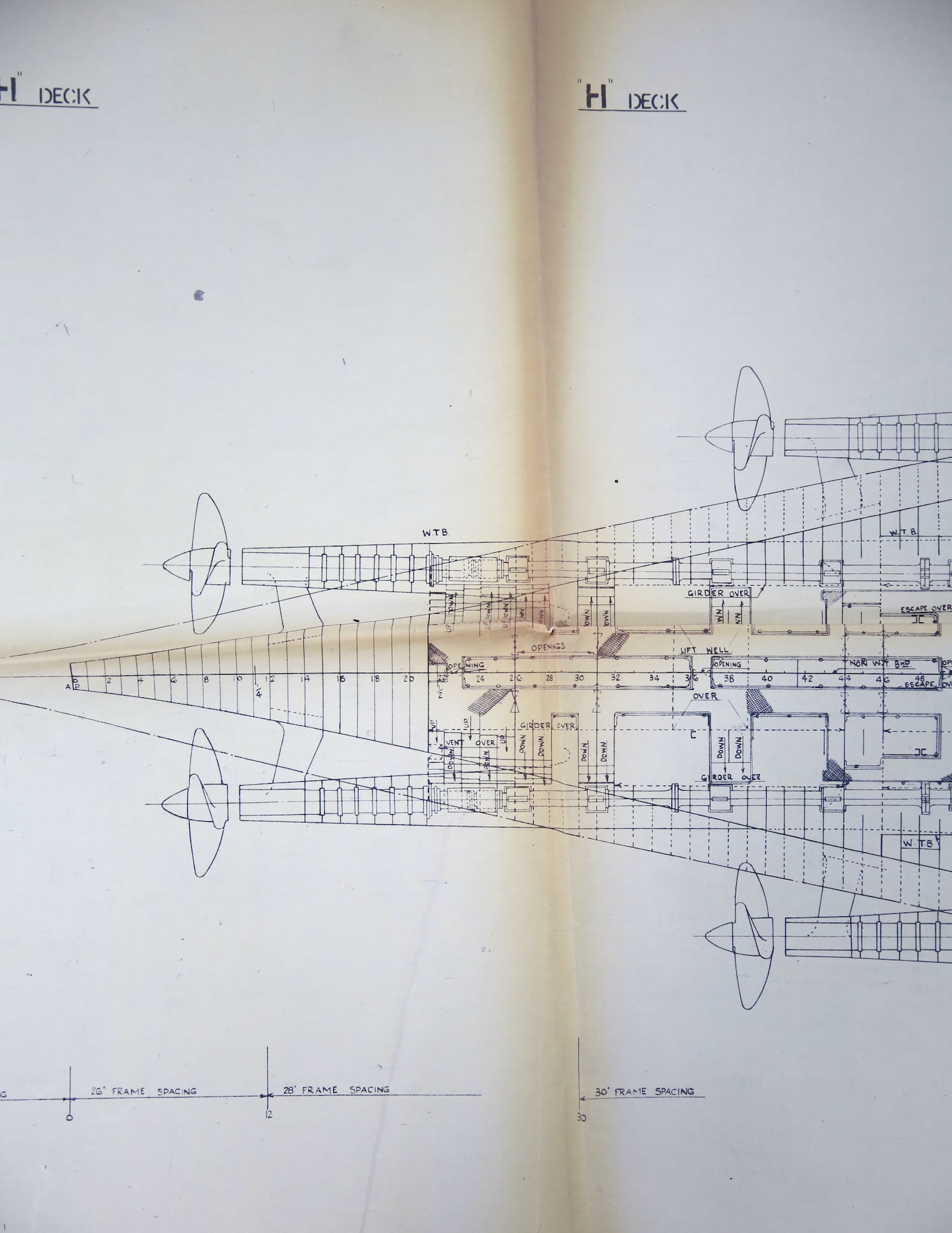 Abraham Lincoln
If given the truth, the people can be depended upon to meet any national crisis...
Abraham Lincoln
If given the truth, the people can be depended upon to meet any national crisis...
 Guildford news...
for Guildford people, brought to you by Guildford reporters - Guildford's own news service
Guildford news...
for Guildford people, brought to you by Guildford reporters - Guildford's own news service
For £25, How Luxury Liner Queen Mary Was Transformed Into Giant Wartime Troopship
Published on: 13 Mar, 2021
Updated on: 17 Mar, 2021
A £25 find at a car boot sale 25 years ago revealed how the legendary luxury cruise-liner RMS Queen Mary was converted into a giant wartime troopship.
The documents are now expected to fetch up to £4,000 when they come up for auction at Ewbank’s in Surrey on March 26.

Head of valuations Jack Wallis, left, holds up one of the 11ft long plans with Ewbank’s partner Andrew Ewbank.
And the plans nearly ended up in a bonfire, the owner revealed. He bought them after the car boot vendor said he planned on burning them if they didn’t sell.
The full set of plans for converting the requisitioned Queen Mary, among the three grandest liners of the golden age of steam, comprise 14 individual sheets, each measuring 11ft long by 2ft wide, packed with intricate details of how the ship was stripped to make way for nearly 17,000 troops plus the crew.
This meant removing six miles of carpet, 220 cases of china, crystal and silver services, tapestries and paintings for storage for the duration of the war.
Protecting the luxury fixtures meant covering the woodwork in the staterooms, the cabin-class dining room, and other public areas with leather.
Built in the mid-1930s by John Brown on Scotland’s Clydeside and launched by the Cunard-White Star Line, the 80,000-ton RMS Queen Mary won the Blue Riband for the fastest Atlantic crossing just a few months after her maiden voyage in May 1936.
Along with RMS Queen Elizabeth and the French liner SS Normandie, she was the largest and pre-eminent luxury liner at the peak of the cruising age, plying between Southampton and New York via Cherbourg.
The Queen Mary arrived in New York as Britain declared war against Germany on September 3, 1939, and remained there alongside the Normandie for the next six months then they were joined by the Queen Elizabeth, which made a dash across the Atlantic to safety from Clydebank.
All three ships were to be troop carriers, but the Normandie was destroyed in an accidental fire during the conversion. The Queen Mary left for Sydney to transport troops from Australia and New Zealand.
The luxurious fittings, including stateroom furniture and fine decoration had been removed and stored, to be replaced by triple-tiered wooden bunks. Anti-mine protection was applied to the hull, and the grand cruising black, white and red colours of her hull and funnels were painted over in Royal Navy grey.
Apart from size, the ships were ideal for transporting troops safely because of their speed of more than 32 knots (nearly 38mph), which meant they could outrun the lethal Nazi U-Boats. Soon, the Queen Mary was known as the Grey Ghost.
But on October 2, 1942, tragedy struck. Carrying thousands of American troops to join the Allied forces massing in Britain, the Queen Mary accidentally ploughed directly across the deck of her cruiser escort, HMS Curacoa off the Irish coast. The cruiser sank with a loss of 239 lives.
Less than a year later, the Queen Mary set a record for the largest number transported on a single vessel carrying 15,740 soldiers and 943 crew. The voyage was memorable for another reason.
While 700 miles off the Scottish coast, she pitched and rolled in an enormous storm, once hit by a wave estimated to have been almost 100ft high. A report said she was just three degrees from capsizing.
Among the Queen Mary’s many VIP passengers she carried Prime Minister Winston Churchill across the U-boat-patrolled Atlantic to meet US President Franklin D Roosevelt. He travelled incognito, listed on the passenger manifest as Colonel Warden.
After the war, all the Queen Mary’s former glories were restored and back she went back to Atlantic cruising. In 1949, she accidentally ran aground off Cherbourg in 1949 (she was refloated the next day), and continued in service into the jet age. Then passenger numbers fell away dramatically as people took to the skies for the much faster crossing. Eventually, she was sold off and can now be found moored permanently off Long Beach, California as a tourist attraction.
Dr Rintoul, a wartime ship’s surgeon, or his father Colonel Rintoul, may have acquired the plans. Ewbank’s head of valuations, Jack Wallis, said: “These were an exceptional find for a car boot sale. All the more so because the set is complete and has been well-preserved.
“The additional research and care by the vendor over the intervening 25 years, and their conversion of the plans on to computer discs being offered alongside them, make this a very attractive lot for any bidder interested in this fascinating slice of history. “The estimate is £3,000 to £4,000 and they can be viewed online at www.ewbankauctions.co.uk with details about live bidding online.

See Dragon story: GBC’s Explanation of Major Land Sale Notice Error ‘Borders on Arrogant’ Says Councillor






Recent Articles
- Police and Crime Commissioner Candidate Interview – Paul Kennedy
- Staff Union Warns Surrey University of No Confidence Votes
- Invitation to Join Mass Bike Ride on Saturday, April 27
- Thames Water Clarify Compensation Payments
- Surrey Fire and Rescue Service Urges Us All To Be ‘Wildfire Aware’
- Police and Crime Commissioner Candidate Interview – Lisa Townsend
- Insights Part 3: The Council Should Not Be Marking Its Own Homework
- Notice: In Our Own Words
- Highways Bulletin for April 22
- M25 Junction 10 Project Required Major Engineering to Overcome Pipeline Snag


Search in Site
Media Gallery
Dragon Interview: Local Artist Leaves Her Mark At One of England’s Most Historic Buildings
January 21, 2023 / No Comment / Read MoreDragon Interview: Lib Dem Planning Chair: ‘Current Policy Doesn’t Work for Local People’
January 19, 2023 / No Comment / Read MoreA3 Tunnel in Guildford ‘Necessary’ for New Homes, Says Guildford’s MP
January 10, 2023 / No Comment / Read More‘Madness’ for London Road Scheme to Go Ahead Against ‘Huge Opposition’, Says SCC Leader
January 6, 2023 / No Comment / Read MoreCouncillor’s Son Starts Campaign for More Consultation on North Street Plan
December 30, 2022 / No Comment / Read MoreCounty Council Climbs Down Over London Road Works – Further ‘Engagement’ Period Announced
December 14, 2022 / No Comment / Read MoreDragon Interview: GBC Reaction to the Government’s Expected Decision to Relax Housing Targets
December 7, 2022 / No Comment / Read MoreHow Can Our Town Centre Businesses Recover? Watch the Shop Front Debate
May 18, 2020 / No Comment / Read More











Recent Comments